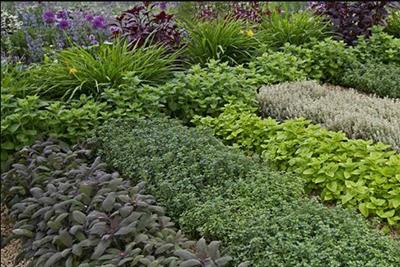
Saturday February 20, 2021
By Trevor Ross
 Growing
Growing
Companion planting, or companion gardening, is not a new idea. It’s actually been around since the beginning of agriculture as what we call “polyculture” farming – multiple plants on the same land – as opposed to “monoculture” farming, done with only one type plant. Vast expanses of corn, wheat, or other singular crops are the contemporary standard for commercial farming, and even residential gardening. However, any green thumb will concede that repeatedly cultivating a single crop will also have a repeated single effect on your soil, depleting necessary nutrients. It will also turn your plot or grow room into a reliable buffet for pests.
The answer, then, as ancient as farming itself, is to collect plants that support each other. One plant consumes loads of this or that nutrient, while another returns the same chemical to the soil. Still another repels pests, and its neighbor attracts pollinators. Companion gardening harnesses the synergy of naturally occurring processes for a truly organic product. Here are some companions your cannabis could benefit from.
Pest Control Plants for Cannabis
These plants can help mitigate any unwanted creepy crawlers from making their way onto your crop,
Basil
Two of the most common cannabis pests are aphids and spider mites, and this common herb will discourage both from coming near your precious plants. The strong scent also repels many flies that could otherwise act as pests themselves, or lay eggs in the soil or underneath your leaves. There are rumors of nearby basil increasing cannabis oil production, but this has not been consistently verified.
Garlic
The scent of growing garlic is largely contained underground, but that means it’s deterring maggots and burrowing insects that might attack your cannabis root systems.

Garlic is also known to inhibit fungal growth (remember this may be harmful to growers cultivating beneficial mycorrhizal fungus in their soil).
Pot Marigolds
Marigolds actually attract many pests, and so are used as a trap companion to keep pests in one area and away from others. Planting them alongside your cannabis may bring insects too close for comfort, but you can keep pots of them around the garden or grow room to entice the little monsters to move away from your more valuable plants
Mint
Many pests avoid the abrasive aroma of mint. That same bullish scent can also camouflage your cannabis if you prefer to keep your crop private.
Be warned, however, that mint grows aggressively, and can be difficult to tame.
Many gardeners use mint, but keep it contained to small pots placed strategically around the garden.
Dill
Dill is famous among gardeners for attracting predatory insects like ladybugs, mantises, and wasps. While you may not like the idea of wasps in your garden, unwelcome bugs nesting in your marijuana leaves like it a whole lot less. Dill also supports pollinators like bees and butterflies.
Companion Plants for Soil Enrichment
In addition to companion planting for pest control, there are also methods for boosting soil quality and adding enrichment.
Alfalfa
These sprouts are very common in gardens of any kind as both ground cover to prevent weeds from taking hold, and as an offseason crop. Alfalfa absorbs nitrogen from the air and stores it primarily in their roots. When it’s time to plant again, the alfalfa is mulched up and stirred into the soil, releasing those stores of nitrogen for the next plant to feed on.
Chamomile
Of course, the scent of chamomile will dissuade some pests from approaching your plants, but this aromatic is truly renowned as an antifungal.

The tea from it can be sprayed on your cannabis leaves to reduce the risk of molds and mildews from establishing themselves and contaminating your crop. Like other entries here, it can be mulched to release potassium and calcium into the soil.
Borage
Another common companion, borage is known for being able to absorb trace nutrients that other plants may not be able to uptake. Elements like potassium and calcium are collected in the leaves, which can then be mulched into the shallower layers of the soil for other plants in your grow to more easily absorb. Borage also thrives in similar conditions as cannabis, making this partnership easy to maintain.
Legumes
Legumes encompass a wide range of seed pods including beans, peas, and lentils. Many of them benefit from a symbiotic bacteria that absorbs nitrogen from the air and converts it into usable food for the plant.

Whether or not this extra nitrogen is shared among neighboring plants has produced mixed results in the lab, but indigenous North Americans have been successfully using beans in their Three Sisters polyculture for centuries.
Clover
Clover is an excellent ground cover crop, preventing unwanted weeds from moving in, while the root systems aerate the soil and improve water flow. Clover is also a member of the sprawling legume family and shares the ability to draw additional nitrogen into the soil. Regardless of how effective the clover may be at sharing that nitrogen, anything that naturally raises the “global” nitrogen level of your garden will inevitably benefit your cannabis plants. Finally, it will produce an abundant and continuous crop for mulch and teas.
Conclusion
Polyculture gardening is increasingly popular among any grower striving for a full, organic product. Many pesticides warn not to use their product on fruit- or vegetable-producing plants because the effects of ingestion have not been thoroughly scrutinized. The same is true for combustion or inhalation.
The natural fertilizing processes are also increasingly replacing abrasive chemical fertilizers in both home and commercial operations. And many home-growers appreciate the full garden that extends from their cannabis plants, with bright colors and fresh scents inviting beneficial wildlife. So do right by your cannabis plant, and give it some companions to harmonize with!
How has companion planting been useful for your garden? Share your experiences in the comments below!
Photo Credit: ilovegrowingmarijuana (license)







